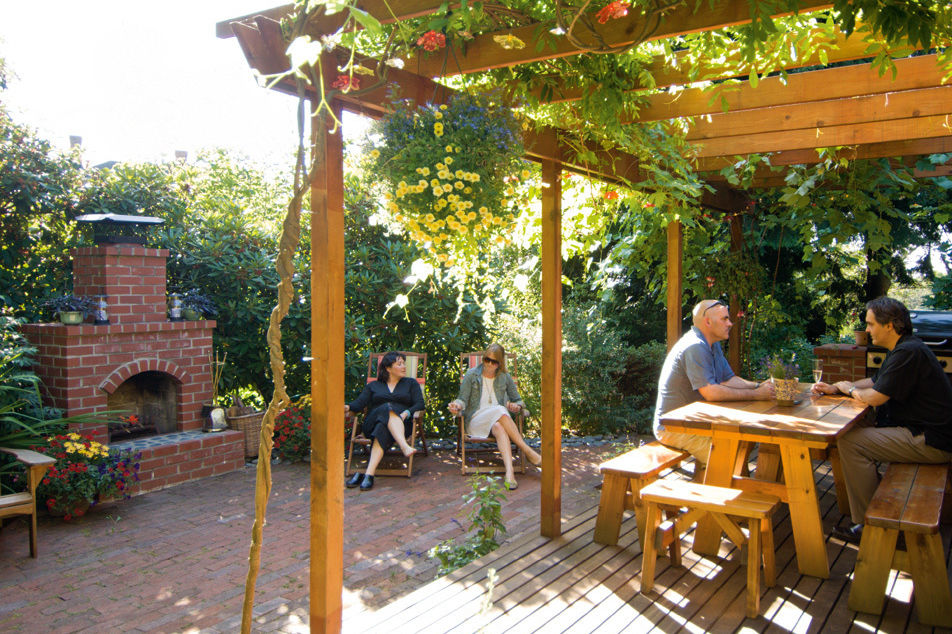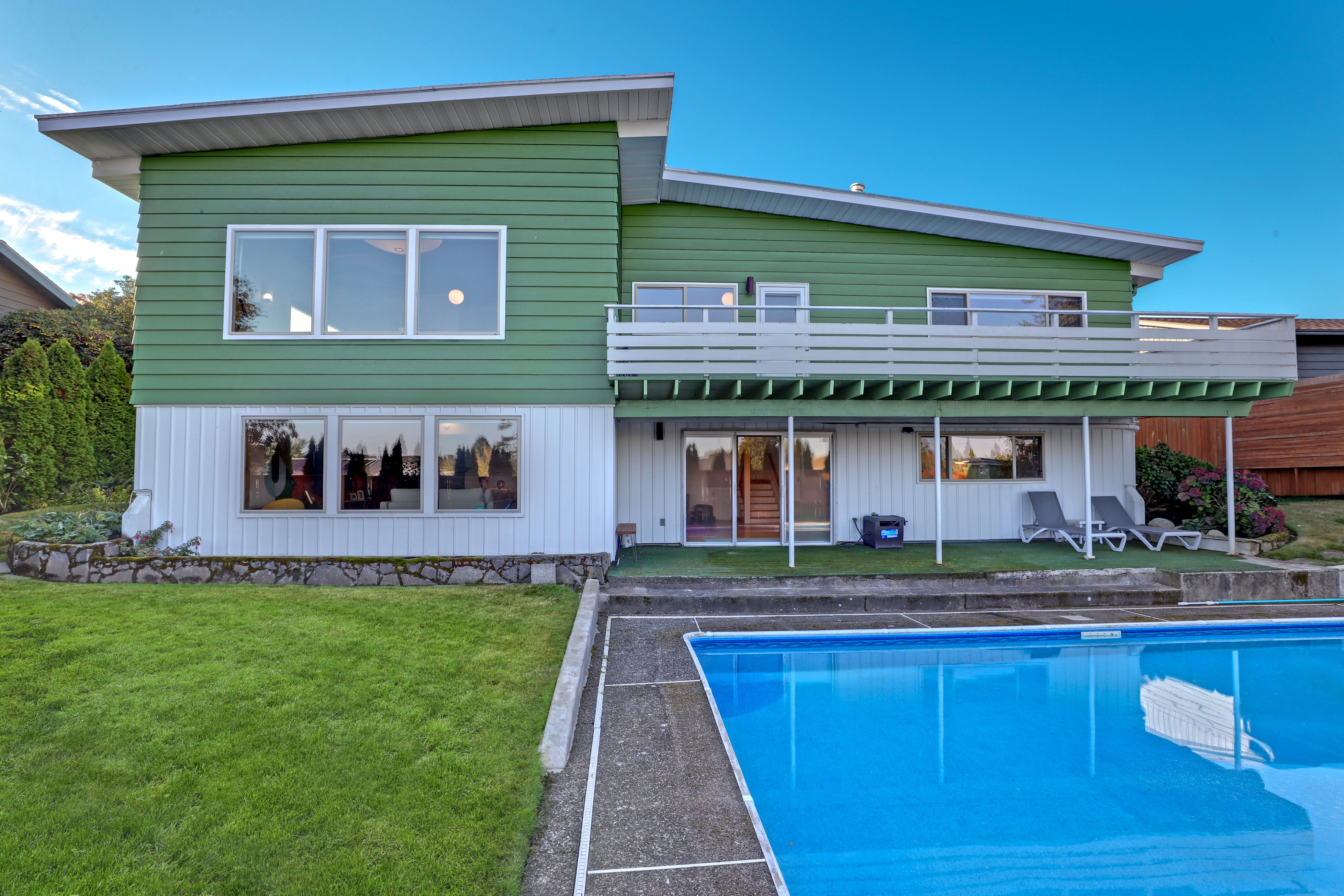Inside Connection
AFTERNOON SUN FLOWS through French doors into MK Guth and Greg Landry’s dining room, splashing bright squares of light across the Persian rug. Sparingly appointed with contemporary prints, a teak dining table, and a white-paper George Nelson “Saucer” lamp that hovers over the table, the room is at once welcoming and coolly urbane. Outside, a wisteria arbor veils a cedar deck, and beyond that, Adirondack-style chairs cluster on an inviting brick patio.
The tranquil domestic scene in this Mount Tabor cottage calls to mind the subject of a museum installation that Guth, a conceptual artist and chair of the Pacific Northwest College of Art’s visual studies MFA program, created earlier this year. One of 81 artists selected to participate in the prestigious 2008 Whitney Biennial in Manhattan, Guth contributed an 1,800-foot-long braid, woven from artificial hair and flannel ribbons (the piece will be shown this November at the Portland Art Museum). Inscribed on the fabric were responses, collected from members of the public, to Guth’s question “What is worth protecting?”
Looking around the interior of Guth’s home, a few obvious answers come to mind. Like the couple’s art collection, which includes a cheerful abstract painting by Portland-based artist Mike Shea and a whimsical house of cards sculpture by Brooklyn-based Peter Kreider. Then again, it’s good home design—harder to carry off, both literally and figuratively, than beautiful possessions—that makes this abode particularly covetable.
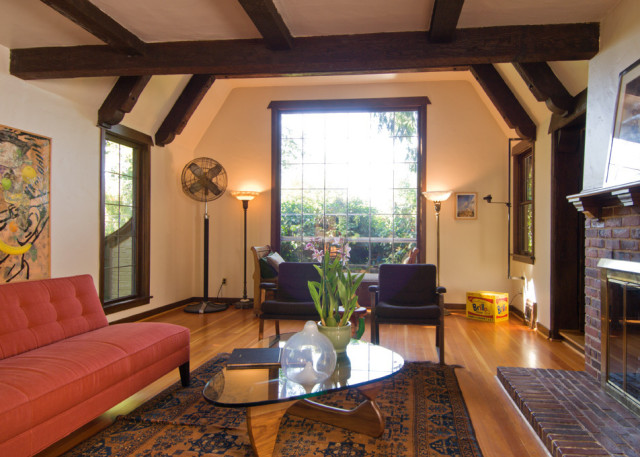
INSPIRATIONAL ORIGINS Architect Martin Houston matched the living room ceiling’s unusual angled corners and exposed joists (above) in the new dining room addition.
Image: Jon Jensen
Guth and Landry credit their architect, Martin Houston, with making the change that, according to Landry, transformed the character of the whole house. The two recruited Houston to design the dining room and deck addition for their 1937 residence. By placing the dining room at the rear (southeast) corner of the main floor, and building a deck off of that, Houston connected the couple’s interior living space with the garden, turning a formerly bottled-up area into a series of indoor and outdoor rooms attuned to light and site.
But it’s clear that Houston had the advantage of clients who themselves possess a flair for organizing space—and for creating a sensual and rich sense of place. That becomes evident as Guth, a youthful-looking 45-year-old whose long hair is streaked with brown and blond, walks me through her garden. The small backyard slopes upward and is interwoven with grassy expanses, contemplative enclosures, and a planting bed that exudes a seasonal outpouring of scents (daphne, Sarcococca, and Pieris in the spring; lavender, Corsican mint, and thyme in the summer). We stroll past a minimalistic fountain, water dripping down a slab of rock, and a sunny patch of herbs, which sits at the base of an ivy-covered retaining wall.
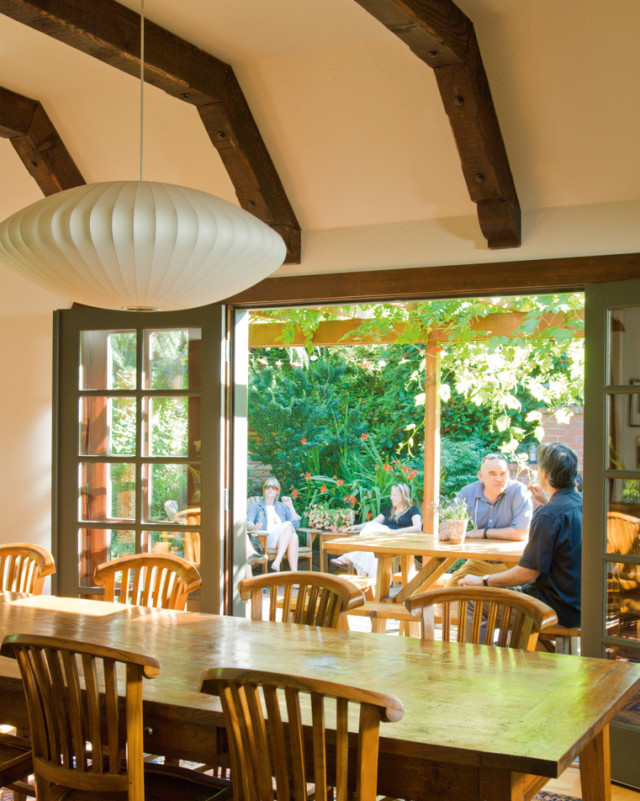
ROOM WITH A VIEW Entertaining is easy, rain or shine, with a new dining room and deck connected by French doors. Guth and Landry bought their teak dining room table from Chantiques.
Image: Jon Jensen
The creative impulses that inspired the garden aren’t so different from the ones that drive her art, Guth says, after describing one of her projects, Red Shoe Delivery Service, in which she provided free chauffeur service to people who donned glittery flats and clicked their heels together. “In a lot of my projects I’ve thought about space and how people operate in it,” she says. “And this house is an extension of that.”
It’s also the fruit of a 30-year romance, and all the attendant negotiations that come with making a home with one’s partner. High school sweethearts who grew up in Wisconsin, Guth and Landry moved to Portland in 1991 when Landry, then in training as a vascular surgeon, signed on for his residency at Oregon Health & Science University (OHSU). They married the following year, bought a fixer-upper in Southeast Portland’s Sunnyside neighborhood, and poured a few years of sweat into renovating it. In 2003, Landry was practicing at OHSU and Guth was in Manhattan—showing her work in the art capital after completing a two-year MFA program at New York University—when Landry called Guth to tell her he’d developed a crush on a new house. “I know this sounds crazy, but I think you should get on a plane,” he said.
A tour of the two-story, 1,800-square- foot house left Guth skeptical, despite the way the residence nestled cozily into the Mount Tabor lot, and the way its leaded-glass windows and decoratively carved, dark-stained ceiling joists gave it a pleasing “alpine-medieval” character, as Landry puts it. The property had been badly neglected by its absentee owner: Blackberries had overtaken the backyard, the plumbing was sprouting leaks, and one of the home’s two fireplaces was falling down. “I saw it for what I thought it could be,” Landry says. “She saw all the work it would take to get there.”
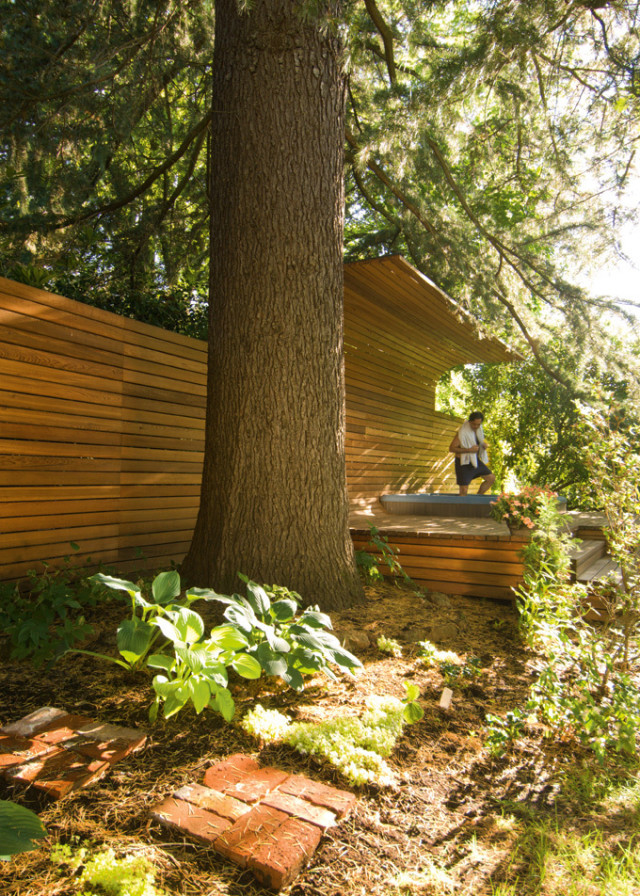
SOAKING UP NATURE Guth and Landry hired contractor Mark Straw to build the fence; designed by Wright Design Office, it curves to shelter the hot tub.
Image: Jon Jensen
But Guth relented. “There are three fireplaces,” she says by way of explanation (that includes the outdoor hearth they’ve since built). “I’m from Wisconsin. I’m always looking for a place to keep warm. It’s ideal.” Soon she and Landry owned the house, and Guth was back in Portland, hiring contractors to repair the busted pipes and overhaul an outdated electrical system, and completely redoing the garden, a project that became a yearlong obsession. She dug up the blackberry vines and a crumbling concrete dog run, and even joined the Hardy Plant Society and the Fuchsia Society in a quest to procure unusual specimens for her planting beds.
By 2005 the garden was taking shape, and the home’s basic infrastructure was in working order. The living room and the two upstairs bedrooms were furnished, and the formerly decrepit fireplace in the third bedroom, which had become Guth’s main-floor office, was standing tall. But one important element was missing: The house had a large living room and a small kitchen nook, but no dining room. Which is where Houston, who was an old friend of theirs, came in. “It’s a great thing to sit with him over a beer, talk about what we want in a house, and draw on napkins,” Guth says.
With an exterior wall made from French doors, as well as interior doorways connecting to the adjacent living room and kitchen nook, the new dining room establishes a continuous circuit between indoor and outdoor spaces, accommodates 12 for dinner, and adds 300 square feet to the house. That satisfied Guth and Landry, who remained in remarkably solid accord about the direction of the remodel. Although Landry admits that when it came time to decorate, he had to let go of his original alpine-medieval vision. “We had a huge argument about whether we should get an antler chandelier,” Guth says, laughing. Happily, the Nelson lamp won out.
